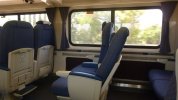Double-decker trains could soon run from London to Paris
Plans by Virgin and Eurostar would significantly increase capacity on busy Channel Tunnel route
14 May 2025 1:46pm BST
Double-decker trains could run through the Channel Tunnel by the end of the decade under plans being
drawn up by Eurostar and Sir Richard Branson’s Virgin Group.
The rival rail operators are contemplating orders of a two-tier version of the
French TGV train, in a move that would significantly increase capacity on the busy London-Paris route.
It would also give Britons a taste of the double-decker train travel that has been commonplace in continental Europe for decades.
Eurostar said that opting for a double-decker design is “a possibility” as it moves towards placing an order for up to 50 new trains by the end of this year.
Advertisement
Talks are under way with multiple manufacturers for the order, a spokesman said. Those include Alstom, the manufacturer of the original fleet of TGV-based Eurostar trains that are capable of speeds of 350 km/h (217 mph).
Eurostar’s majority owner, French state railway SNCF, has operated twin-deck TGVs since 1996.
Sir Richard’s Virgin Group also said it would consider double-deckers as it bids to operate trains through the Channel Tunnel in competition with Eurostar.
A spokesman said potential suppliers included Alstom as it seeks “the best trains to meet our cross-Channel rail ambitions”.
Opting for a high-capacity model might enhance Virgin’s credentials amid efforts to win approval for the move from UK regulators.
Gemini Trains, led by rail industry expert Lord Tony Berkeley, and Evolyn of Spain, which is working with Italy’s state rail operator, are also in the running to
end Eurostar’s 30-year monopoly on cross-Channel services
Henri Poupart-Lafarge, Alstom’s boss, said it was in talks to run double-decker trains through the Channel Tunnel, where he said they could both increase capacity and bring down fares.
He told the Financial Times: “The double-decker train has a lot of advantages. It’s a very high-speed train with the lowest cost per seat and the highest capacity.”
The High Speed 1 line from Folkestone to St Pancras station was built to European standards, meaning there should be no issue in accommodating the increased height of the trains, an Alstom spokesman said.
While gaining approval for double-deckers to run through the tunnel would take some years, they should be available within the timescales being explored by Eurostar and Virgin.
Advertisement
However, Alstom has limited production capacity and outstanding orders for the two-tier TGV, so it may be a case of “first come, first served” in bringing the trains to the Tunnel, he said.
The firm’s newest twin-deck model, the Avelia Horizon, which has more than 100 orders, is set for its first delivery next year.
While the top level of a double-decker offers a better view for passengers, the trains have a mixed reputation in Europe.
Stairs to the top level can be hard to negotiate for some passengers and boarding times are inevitably longer. A seat on the bottom deck also tends to be lower and can require steps down.
Britain’s only foray into double-decker trains came after Second World War, when two experimental commuter models served London Charing Cross.






